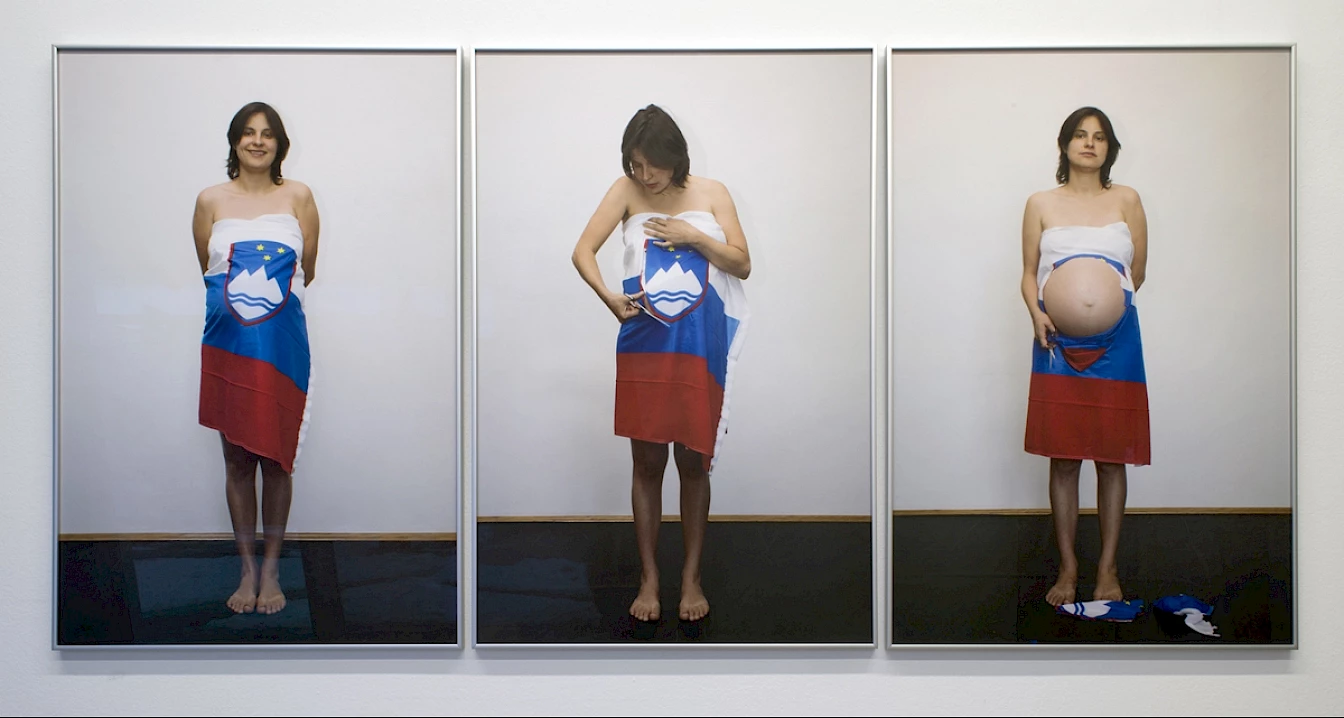
Simona Semenič and Nada Žgank, Note to an Entirety, 2009 (printed 2018). On display in the vestibule of the Museum of Contemporary Art Metelkova as the Commentary #8 from 5 March to 15 May 2018. Photo of the display: Dejan Habicht © Moderna galerija, Ljubljana.
According to Sigmund Freud, in his Civilization and its Discontents, the civilization that distinguishes our lives from those of our animal ancestors and serves two purposes – to protect man from nature and to adjust his mutual relations – does not make us feel comfortable. The entry into and becoming through culture and the discontent embodied in it is also examined in the work of Slovenian intermedia artist Maja Smrekar. Smrekar focuses on the latest geological era, the Anthropocene, in which the human race subjects the environment to global exploitation of natural and human resources. The artist, who won the Golden Nica award at the Ars Electronica festival in the category of hybrid art in 2017, stages posthumous dystopias inhabited by hybrid biological and biotechnological species and by extension opens up reflection on an expression of society based on a more balanced coexistence of human beings with the ecosystem. In her work she draws on Western mythology, technological practices past and present, gender theory and biopolitics; her treatments and audacity absorb the viewer in a broad field of though-provoking associations, but by the same token can also serve to trigger unreflective repulsion.
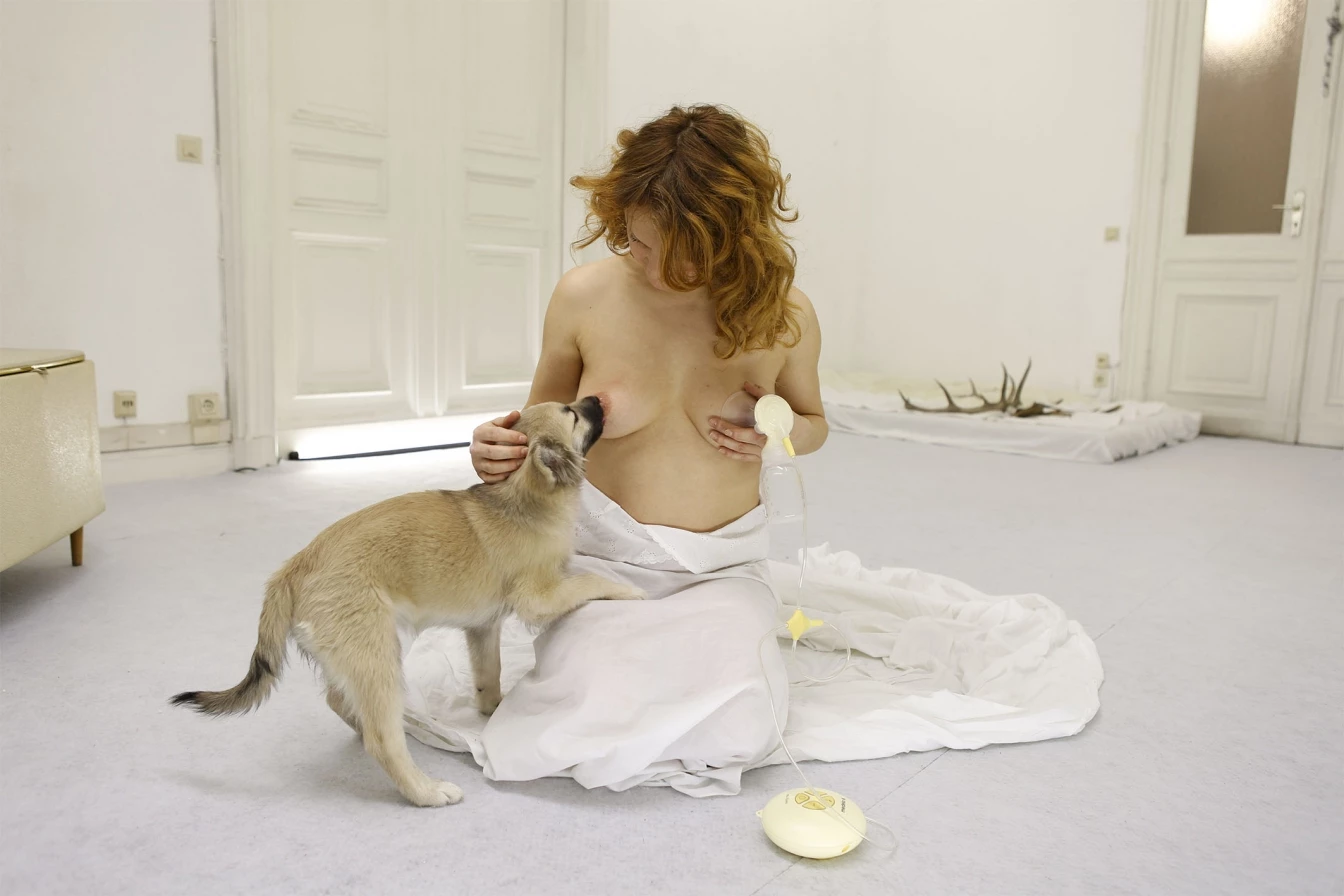
Maja Smrekar, K-9_topology: HYBRID FAMILY, 2016. Photo: Manuel Vason.
The complex four-part series K-9_topology was carried out between 2014 and 2017 in cooperation with scientists and technologists and was produced by Kapelica Gallery and the BioTehna laboratory of the Kersnikova Institute in Ljubljana, the foremost Slovenian and internationally established centre for intermedia art. In the series, she employs a topological method to address the physical, relational and signifying space on the margins of which culture and nature, personal and collective memory, and different temporalities are intertwined. As the author explains, the title derives from the code used for professional police dogs: the letter K and the number 9 are homophones and, when said together, constitute syllables to produce canine (dog).
K-9 Topology, a series of four autonomous projects, was exhibited at Ars Electronica on a wooden construction otherwise used for training show dogs. In her first project Ecce canis (Behold the Dog) in 2014, she addressed the historical domestication and transformation of the wolf to the dog and the mutual adaptation of human and dog, which includes a genetic dimension. In their coexistence with human beings, dogs acquired the ability to metabolise carbohydrates and starch, while humans lost their acute sense of smell and instead evolved with a sharper sense of sight and hearing. The author symbolised the emotional tie developed between dogs and humankind over the course of their coexistence with the sense of smell, in which her own serotonin hormone was combined with the serotonin of her dog Byron. Alongside the equipment she used to conduct the laboratory part of the project, she placed a huge horn lined with wolf skins at a depth at which visitors could smell the human-dog alliance.
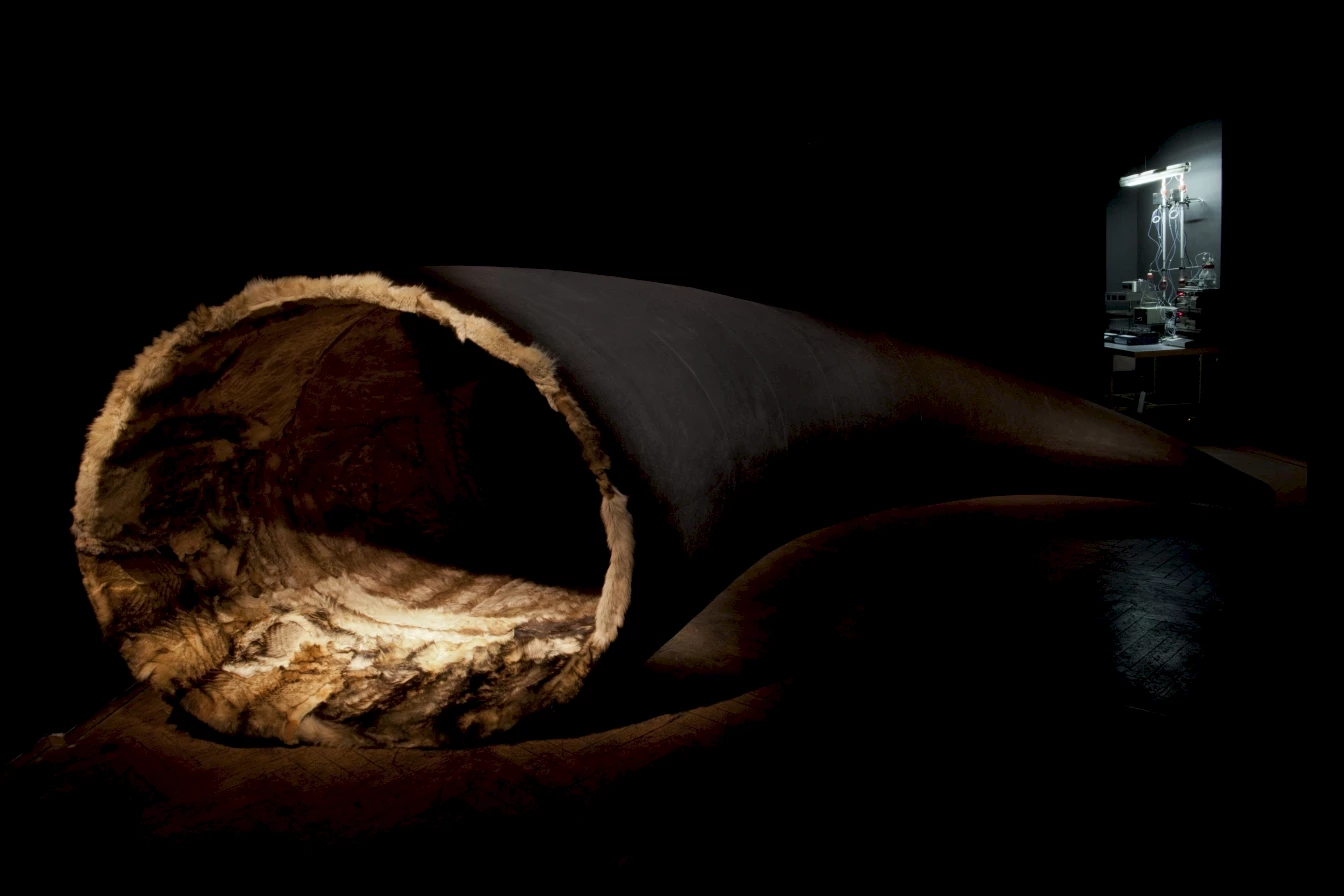
Maja Smrekar, K-9_topology: ECCE CANIS, 2014. Photo: Miha Fras.
In the Jacana Wildlife Studio in France in 2014, she prepared and then performed I Chase Nature and Culture Chases Me – a reference to Joseph Beuys's 1974 performance with a coyote entitled I Like America and America Likes Me – in the Bandits-Mages cultural centre in Bourges, as part of the Rencontres festival. Here she lay on the floor with her naked body covered in grease and starch licked by two dogs and a wolf from the pack with which she established contact in Jacana, while a poetic sound narrative played intertwining her memories from childhood – of dogs with whom she lived, of the koline (pig slaughter) she witnessed, and more – with statements by artists and theoreticians on the relationship between humankind and nature.
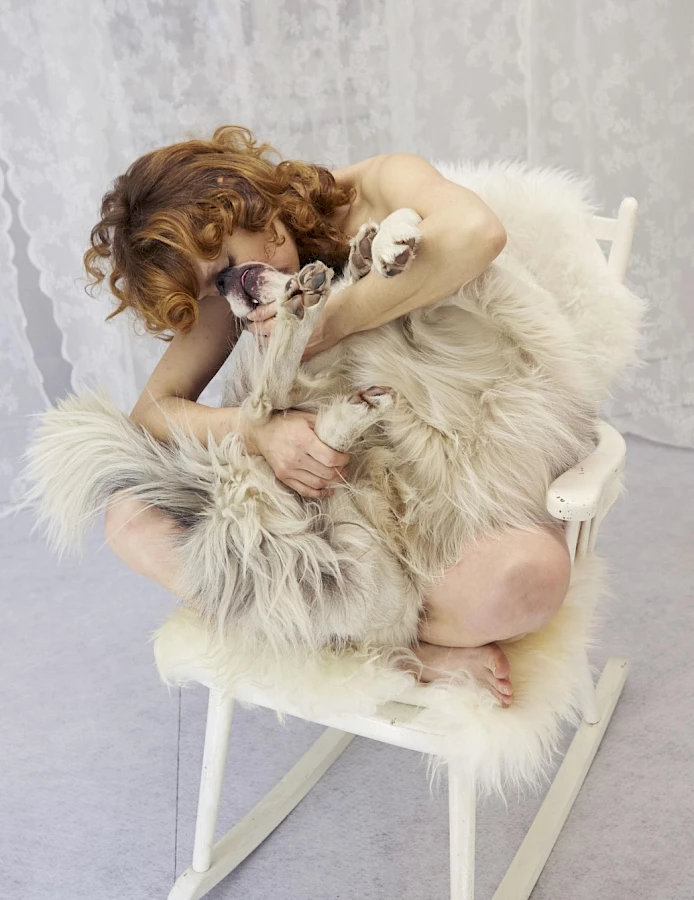
Maja Smrekar, K-9_topology: HYBRID FAMILY, 2016. Photo: Manuel Vason.
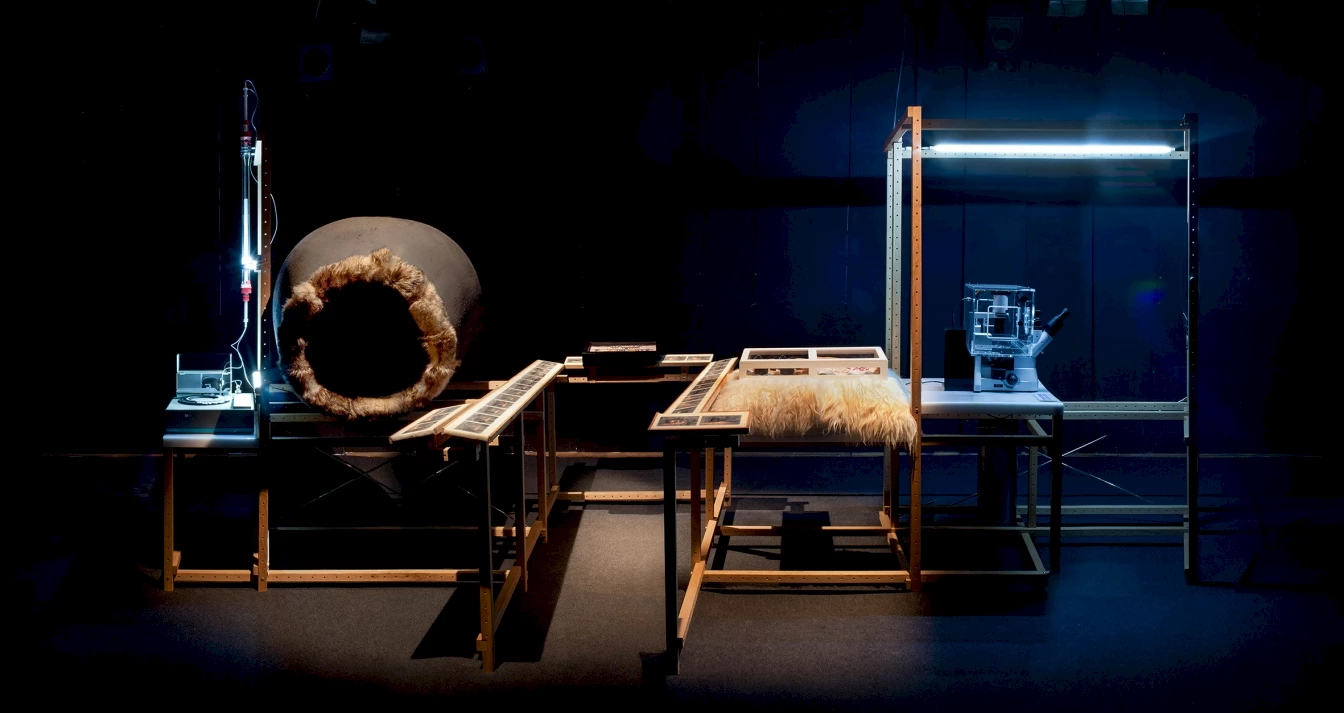
Maja Smrekar, K-9 topology, 2017 at Galerija Kapelica. Photo: Miha Fras.
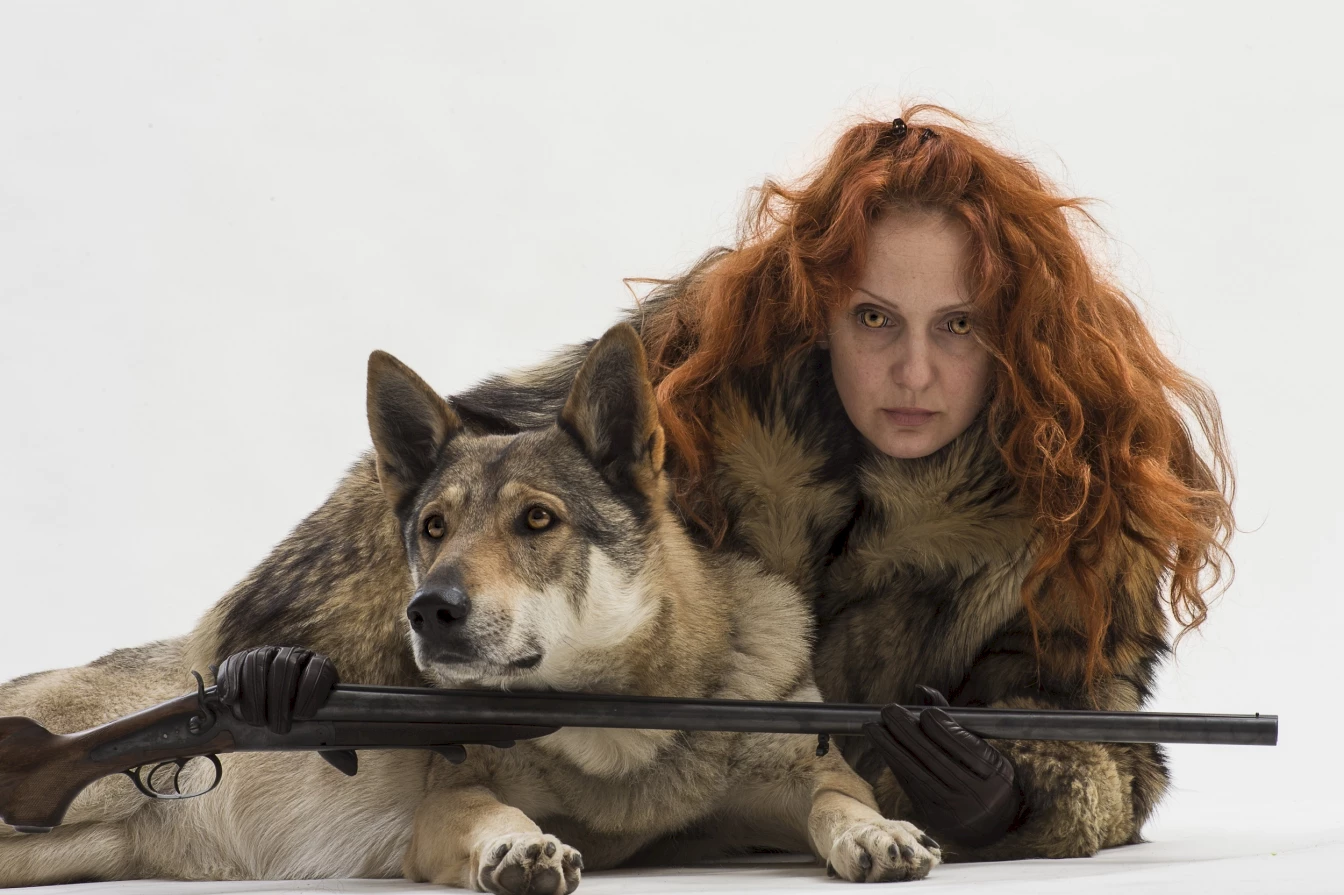
Maja Smrekar, K-9_topology: ECCE CANIS, 2014. Photo: Borut Peterlin.
In the third part of the series, Hybrid Family, carried out between autumn 2015 and February 2016, she focused on the instrumentalisation of the female body and breastfeeding and the historical transformation of the concept of family. While consuming galactogenic liquids and foods rich in iron, she stimulated her body with breast pumps for months, thus boosting the production of oxytocin and consequently prolactin, which triggered the production and secretion of colostrum. Hunting for meaning, the hunter became prey of her own culture and, in her own words, pregnant with meaning. She transformed herself into the Other within eight weeks, thus becoming the mOther. She enlarged her hybrid family with a new pup Ada, named after Ada Lovelace, mathematician and pioneer of programming and an illegitimate daughter of the poet Byron. In February 2015, in cooperation with the Freies Museum in Berlin, she opened the temporary home of her hybrid family in her Berlin apartment to the audience-public, who witnessed her breastfeeding Ada.

Maja Smrekar, K-9_topology: ARTE_mis, 2017. Photo: Miha Fras.
With the title of the last project in the series – ARTE_mis – the artist referred to the very concept of art and Greek mythology, in which Artemis, the goddess of hunting, is depicted with dogs, while ART is also an acronym for 'assisted reproductive technology'. In the BioTehna laboratory working together with a professional team, she used regular biotechnological procedures to join the cells of two carnivores: all DNA was extracted from the author's ovarian cells and a somatic cell from the dog Ada (taken from her saliva) was then inserted in it. Even before the hybrid cell developed into a blastocyst, it was frozen in liquid nitrogen on the third day and then displayed under the microscope. Next to the big construction was a smaller one displaying a book with the visual materials from the creative process of the K-9_topology series, together with photographs from the artist's childhood. The book without text acts like a kind of margin where the intimate and the social are intertwined; if we adopt a fictitious view in the distant future, a book of images without text can be understood as a memorial album of the genesis and evolution of a (perhaps already extinct) species.
The history of art does not consist of fluid transitions, but of problems and revolts initiated by artistic gestures that change the field of art when they are inscribed in it. Artists often find themselves in a paradoxical situation. Alongside the Golden Nica, Maja Smrekar received the highest Slovenian award for culture, the Prešeren Fund Award, while experiencing a pogrom in the pre-election atmosphere of Austria in 2017 and Slovenia in 2018, initiated in both cases by right-wing populist factions. When Maja Smrekar and playwright Simona Semenič were declared Prešeren Fund laureates in February, social media and some right-wing press circulated their photographs, taken out of context, and accompanied by threats and comments about their desecration of national symbols and the denigration of the Slovenian family with their "disgusting", "degenerative art". The first photograph shows Maja Smrekar breastfeeding Ada, while the other, a photo from ten years previous, shows a heavily pregnant Simona Semenič holding scissors and standing wrapped in a cut Slovenian flag from which her naked pregnant stomach protrudes. Both photographs are about performing the 'extimacy' on the border between nature and culture, between the internal and the external. To paraphrase Mladen Dolar (1994), the broken cultural barrier between the external and the internal gives rise to disgust as a defence mechanism against the Unheimliche – disgust that is both fascinating and repulsive at the same time, and thus supposedly morally deplorable. By breastfeeding a dog pup, Maja Smrekar questioned the concept of the traditional family, while Simona Semenič, an artist pushed to the existential margin, a mother and a precarious worker, cut into the Slovenian national body by cutting a hole in the Slovenian flag from which her and her child's lives protrude.
The concept of culture should also implicitly include the culture of difference, both difference between different cultures and difference within a single culture. While breastfeeding among different animal species is a common phenomenon in certain non-Western cultures, it is now considered disgusting in the West. Western culture, however, includes the myth of Romulus and Remus who were raised on wolf's milk, and, as late as in the nineteenth century, goats were used for nursing human babies whose mothers were infected by syphilis, while women were recommended to breastfeed dog pups to boost their breastfeeding capacity from the eight month of pregnancy onward. While the broader Slovenian cultural scene supported the two artists when they were publicly lynched at the time of the Prešeren Award ceremony, the international intermedia circles were silent in the face of the attacks on Smrekar during the Ars Electronica festival, which instead continued to support the project.
By rejecting cynicism and showing empathy toward the other, regardless of whether this other is a human being, animal, hybrid or environment, Smrekar poses a question related to the future of humankind, starting with the question of the extent to which it will be human at all: will there be hybrids between human and other biological species, possibly bio-technological hybrids; and if so, will these creatures enjoy the same rights as humans? Will human and hybrid beings be granted the rights and dignity that the West has until recently taken for granted but are now increasingly under threat? The contemporary global neoliberal economy is often presented as a neutral, even evolutionary phenomenon that is, paradoxically, bound to nature by the brutal mechanism of survival of the fittest, strongest predators. But while nature is collecting all of humanity's debts, the majority of the population is unable to collect the debts of the privileged minority, even though the right to an individual's freedom is inscribed in our cultural foundations as a precondition of justice. And it is precisely this demand for justice that is one of the key drivers of social revolt and thus of culture. In the case of Maja Smrekar, is both the drive and the issue of the artwork.
Translated from Slovene by Polona Glavan.
Copy-edited by Jeff Bickert.
References:
Freud, S. 1930, Civilization and its Discontents.
Dolar M. 1994, "A Spectre is Haunting Europe", Das Unheimilche, Analecta, Warsaw.
Maja Smrekar is part of the exhibition Heavenly Beings. Neither Human nor Animal, curated by Zdenka Badovinac and Bojana Piškur, on view at the Museum of Contemporary Art Metelkova, Ljubljana from 10 July to 4 November 2018.